Chapter 17: Statement of cash flows
Chapter learning objectives
Upon completion of this chapter you will be able to:
- explain the differences between profit and cash flows
- explain the need for management to control cash flows
- explain the value of a statement of cash flows to users of financial statements
- explain the inward and outward flows of cash in a typical company
- calculate cash flows from operating activities using the indirect method
- calculate cash flows from operating activities using the direct method
- calculate the cash flows from investing activities
- calculate the cash flows from financing activities
- prepare extracts from statement of cash flows from given information.
1 The need for a statement of cash flows
Profit and liquidity
The accounting concepts of accruals and matching are used tocompute a profit figure which shows the additional wealth created forthe owners of a business during an accounting period. However, it isimportant for a business to generate cash as well as to make profits.The two do not necessarily go hand in hand.
Objectives of IAS 7
The Objectives of IAS 7 are to ensure that companies:
- Report their cash generation and cash absorption for a period by highlighting the significant component of cash flow in a way that facilitates comparison of the cash flow performance different businesses.
- provide information that assists in the assessment of their liquidity, solvency and financial adaptability.
The importance of statements of cash flow
Statement of cash flow are an important statement for the users of accounts because:
- They help users to assess liquidity and solvency – an adequate cash position is essential in the short term both to ensure the survival of the business and to enable debts and dividends to be paid.
- They help users to assess financial adaptability – will the company be able to take effective action to alter its cash flows in response to any unexpected events?
- They help users assess future cash flows – an adequate cash position in the longer term is essential to enable asset replacement, repayment of debt and fund further expansion.
- Cash flow means survival – a company may be profitable but, if it does not have an adequate cash position, it may not be able to survive.
- They help to highlight where cash is being generated – the statement of cash flow will clearly detail cash that is being generated from the core activities of the business and other non-operating activities.
- Cash flows are objective – a cash flow is a matter of fact whereas the calculation of profit is subjective.
- they help to indicate problems early.

 Profit
Profit
Profit represents the increase in net assets in a business duringan accounting period. This increase can be in cash or it may be ‘tiedup’ in other assets, for example:
- non-current assets may have been purchased
- there may be an increased amount of receivables
- there may be increased investment in inventory
- the liabilities of the business may have decreased, i.e. more cash has been spent this year in paying off suppliers more quickly than was the case last year.
The benefits of a statement of cash flows
A statement of cash flows is needed as a consequence of the above differences between profits and cash. It helps to:
- provide additional information on business activities
- assess the current liquidity of the business
- allow the user to see the major types of cash flows into and out of the business
- estimate future cash flows
- determine cash flows generated from trading transactions rather than other cash flows.


 The drawbacks of a statement of cash flow
The drawbacks of a statement of cash flow
The drawbacks of a statement of cash flows
- The statement of cash flows is backward looking. Users of the accounts are particularly interested in the future.
- No interpretation of the statement of cash flows is provided within the accounts. Users are required to draw their own conclusions as to the relevance of the figures contained within it.
- Non-cash transactions, e.g. a bonus issue of shares are not highlighted on the face of the statement of cash flows (although they are disclosed elsewhere within the accounts). These are of interest to users as they will impact future cash flows.

2 Format of a statement of cash flows
IAS 7 Statement of cash flows requires companies toprepare a statement of cash flows within their financial statements. Thecash flow must be presented using standard headings.
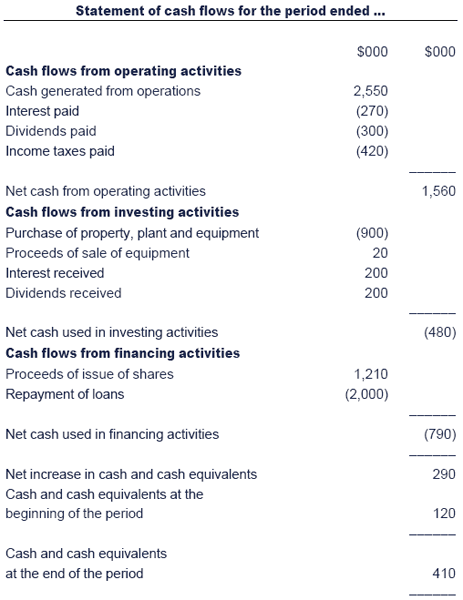

 Key points
Key points
Key points:
- Operating activities are the principal revenue-producing activities of the business. This section of the statement begins with cash generated from operations. This figure can be calculated using either the direct or indirect method.
- Investing activities are cash spent on non-current assets, proceeds of sale of non-current assets and income from investments.
- Financing activities include the proceeds of issue of shares and long-term borrowings made or repaid.
- Net increase or decrease in cash and cash equivalents is the overall increase (or decrease) in cash and cash equivalents during the year. After adding the cash and cash equivalents at the beginning of the year, the final balance of cash and cash equivalents at the end of the year emerges.
- Cash means cash in hand and deposits available on demand.
- Cash equivalents means short-term highly liquid investments that are readily convertible to known amounts of cash and which are subject to an insignificant risk of changes in value. (Investments are thus not cash equivalents unless they have these two attributes of being readily convertible and with little or no risk of change in value.)


 IAS 7 notes
IAS 7 notes
IAS 7 requires a note to the statement of cash flows giving details of the make-up of cash and cash equivalents:


3 Cash generated from operations
There are two methods of calculating cash from operations – thedirect or indirect method. The method used will depend upon theinformation provided within the question.
Direct method
This method uses information contained in the ledger accounts ofthe company to calculate the cash from operations figure as follows:
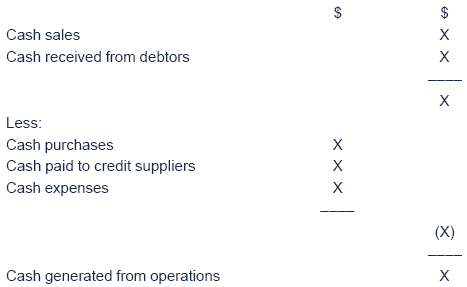

 Examples of using direct method
Examples of using direct method
Example of calculations using direct method
The gross cash flows necessary for the direct method can be derived:
(1) from the accounting records of the entity by totalling the cash receipts and payments directly, or
(2) from the opening and closing statementof financial positions and income statement for the year byconstructing summary control accounts for:
- sales (to derive cash received from customers)
- purchases (to derive cash payments to suppliers)
- wages (to derive cash paid to and on behalf of employees).
Example using control accounts
The statement of financial positions of a business are:

Extracts from the income statement for the year are:

Additional information
(1) Payables consist of
(2) Purchase invoices relating to theacquisition of non-current assets totalling $80,000 have been posted tothe payables ledger during the year.
Calculate the net cash flow from operating activities using the direct method.
Solution

Workings
(W1)

(W2)
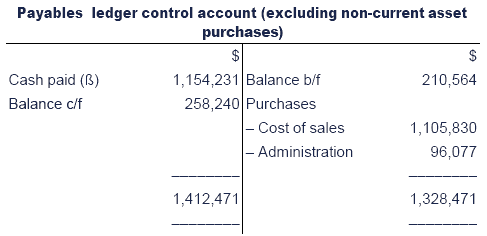
Tutorial note: information relating to non-current assets isnot included in the payables ledger control account above in order tocompute cash paid to suppliers of operating costs.
(W3)
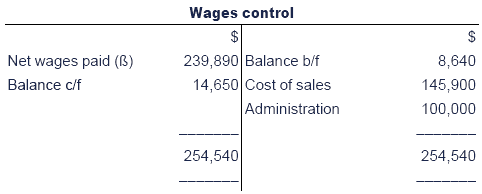

Indirect method
This method reconciles between profit before tax (as reported inthe income statement) and cash generated from operations as follows:

This working begins with the profit before tax as shown in theincome statement. The remaining figures are the adjustments necessary toconvert the profit figure to the cash flow for the period.
Depreciation – Added back to profit because it is a non-cash expense
Interest expense – Added back because it is not part of cashgenerated from operations (the interest actually paid is deducted later)
Increase in trade receivables – Deducted because this is part ofthe profit not yet realised into cash but tied up in receivables
Decrease in inventories – Added on because the decrease in inventories liberates extra cash
Decrease in trade payables – Deducted because the reduction in payables must reduce cash
In order to prepare a statement of cash flows, information from thecurrent and prior year statement of financial position and the currentyear income statement is used. The following financial statementsprovide the source data for the requirements of Test your understanding 1throughout this chapter:

 Test your understanding 1
Test your understanding 1
Requirement 1
Statement of cash flows source data
Statement of financial position of Geronimo at 31 December
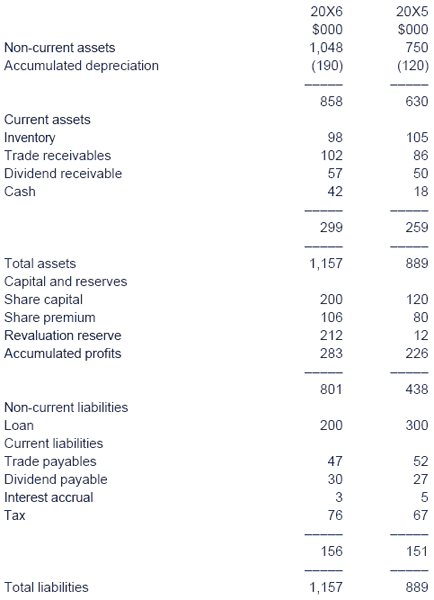
Income statement of Geronimo at 31 December 20X6

Operating expenses include a loss on disposal of non-current assets of $5,000.
- During the year plant which originally cost $80,000 and with depreciation of $15,000 was disposed of.
Calculate the cash generated from operations using the indirect method.

4 Cash from operating activities
Cash flows may include:
- interest paid
- dividends paid
- income taxes paid.
Calculation of interest/income taxes paid
The cash flow should be calculated by reference to:
- the charge to profits for the item (shown in the income statement); and
- any opening or closing payable balance shown on the statement of financial position.
A T account working may be useful:

If there is no change to the opening or closing then it should be the statement of financial position payable amount.
Calculation of dividends paid
The cash flow should again be calculated by reference to thecharge to profits and the opening or closing dividend payable shown inthe statement of financial position.
Note that the charge to profits for dividends is not shown in theincome statement. It can, however, be derived using an accumulatedprofits T account working.

 Test your understanding 2
Test your understanding 2
Requirement 2
Identify and calculate the remaining amounts to be shown under theheading ‘Cash flows from operating activities’ within Geronimo’sstatement of cash flows.

5 Cash from investing activities
Cash inflows may include:
- interest received
- dividends received
- proceeds of sale of equipment.
Cash outflows may include:
- purchase of property, plant and equipment.
Calculation of interest and dividends received
Again, the calculation should take account of both the incomereceivable shown in the income statement and any relevant receivablesbalance from the opening and closing statement of financial positions.
A T account working may be useful:


 Test your understanding 3
Test your understanding 3
Requirement 3
Identify and calculate the dividends and interest received to beshown under the heading ‘cash flow from investing activities’ withinGeronimo’s statement of cash flows.

Calculation of purchase of property, plant and equipment and proceeds of sale of equipment
These amounts are often the trickiest to calculate within astatement of cash flows. It is therefore recommended that T accountworkings are used.
The following T accounts will be required for each class of assets:
- cost account
- accumulated depreciation account
- disposals account (where relevant).
Data provided in the source financial statements should then beentered into these T accounts and the required cash flows found –often as balancing figures.
NB If there is evidence of a revaluation, remember to include the uplift in value on the debit side of the cost T account.
In some cases, insufficient detail is provided to produceseparate cost and accumulated depreciation accounts. Instead, a net bookvalue account should be used:
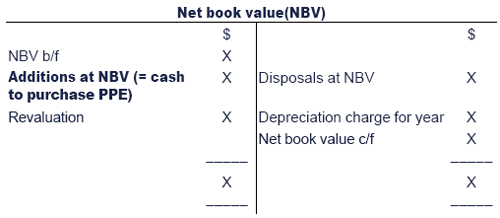

 Test your understanding 4
Test your understanding 4
Requirement 4
Identify and calculate the cash outflow to purchase property, plantand equipment and the proceeds from the sale of equipment to be shownunder the heading ‘Cash flows from investing activities’ withinGeronimo’s statement of cash flows.

6 Cash from financing activities
Cash inflows may include:
- proceeds of issue of shares
- proceeds of issue of loans/debentures.
Cash outflows may include:
- repayment of loans/debentures.
Calculation of proceeds of issue of shares
This cash inflow is derived by comparison of the sum brought forward and sum carried forward balances on two accounts:
- share capital
- share premium.
Calculation of proceeds of issue of loans/repayment of loans
This cash flow is derived by simply subtracting the brought forward balance from the carried forward.

 Test your understanding 5
Test your understanding 5
Requirement 5
Identify and calculate each of the amounts to be shown under theheading ‘Cash flows from financing activities’ within Geronimo’sstatement of cash flows.


 Test your understanding 6
Test your understanding 6
Requirement 6
Complete the following proforma statement of cash flows forGeronimo using your answers to Test your understanding 1 requirements1–5.
Statement of cash flows for Geronimo for year ended 31 December 20X6
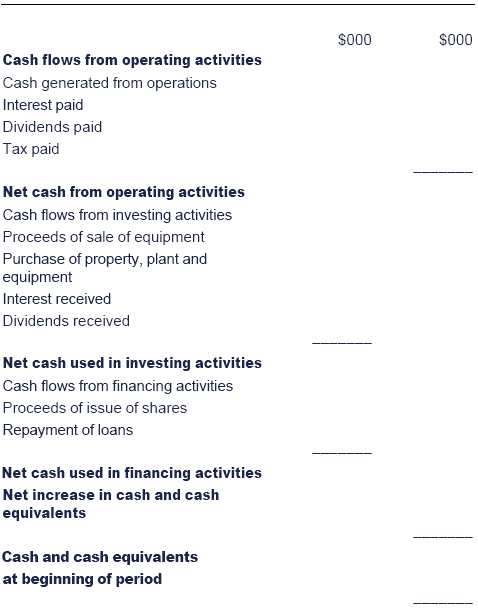
Cash and cash equivalents at end period


 Test your understanding 7
Test your understanding 7
You are given below, in summarised form, the accounts of Algernon, a limited company, for 20X6 and 20X7.

Income statement
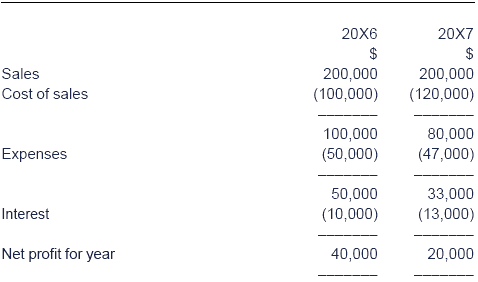
Notes:
A $20,000 dividend has been paid in the year.
(a) Prepare a statement of cash flowsfor Algernon for 20X7, to explain as far as possible the movement in thebank balance. The statement of cash flows should be prepared using thedirect method.
(b) Using the summarised accountsgiven, and the statement you have just prepared, comment on theposition, progress and direction of Algernon.


 Test your understanding 8
Test your understanding 8
Part of a company’s statement of cash flows is shown below:
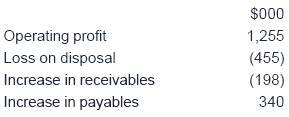
The following criticisms of the extract have been made:
(1) The loss on disposal should have been added, not deducted.
(2) Increase in receivables should have been added, not deducted.
(3) Increase in payables should have been deducted, not added.
Which of the criticisms is valid?
A 1, 2 and 3
B 1 only
C 2 and 3 only
D none of them


 Test your understanding 9
Test your understanding 9
Which of the following could appear in a company’s statement of cash flows?
(1) Proposed dividend
(2) Dividends received
(3) Bonus issue of shares
(4) Surplus on revaluation of non-current assets
A 1 and 2
B 1,2 and 3
C 2 only
D 2 and 3


 Test your understanding 10
Test your understanding 10
The following details are provided to the accountant ofCaddyshack Ltd, which has an operating profit of $469,850 in the yearended 31 December 20X6:
(1) Depreciation of $37,400 has beencharged to the income statement; this included an amount of $7,600 whichwas the loss on disposal of a non-current asset.
(2) The following extract of the statement of financial position at 31 December 20X5 and 20X6 have been provided:

What is the cash generated from operations?
A $511,250
B $510,850
C $501,250
D $503,250

Chapter summary
Test your understanding answers

 Test your understanding 1
Test your understanding 1
Requirement 1

(W1)
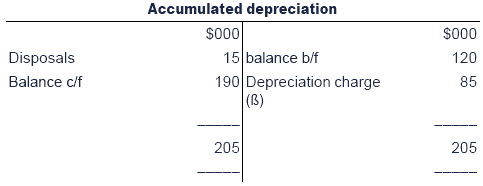


 Test your understanding 2
Test your understanding 2
Requirement 2
Interest paid

Dividends paid
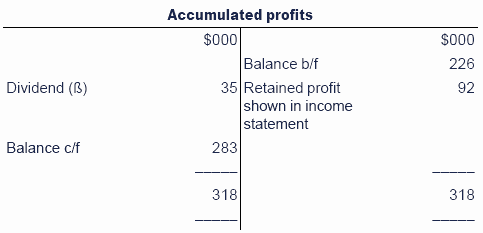




 Test your understanding 3
Test your understanding 3
Requirement 3
There is no balance for interest receivable at the start or end ofthe year; therefore interest received must equal interest receivable inthe income statement
Interest received $15,000
Dividends received



 Test your understanding 4
Test your understanding 4
Requirement 4
(see Solution to Requirement 1 for accumulated depreciation account.)




 Test your understanding 5
Test your understanding 5
Requirement 5
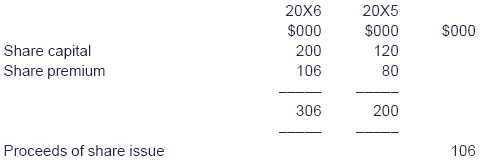
Repayment of loan
- Balance on loan account was $300,000 in 20X5; in 20X6 it is $200,000.
- Therefore $100,000 has been repaid.


 Test your understanding 6
Test your understanding 6
Requirement 6
Statement of cash flows for Geronimo for year ended 31 December 20X6



 Test your understanding 7
Test your understanding 7
Statement of Cashflows for Algernon for year ended 31 December 2007
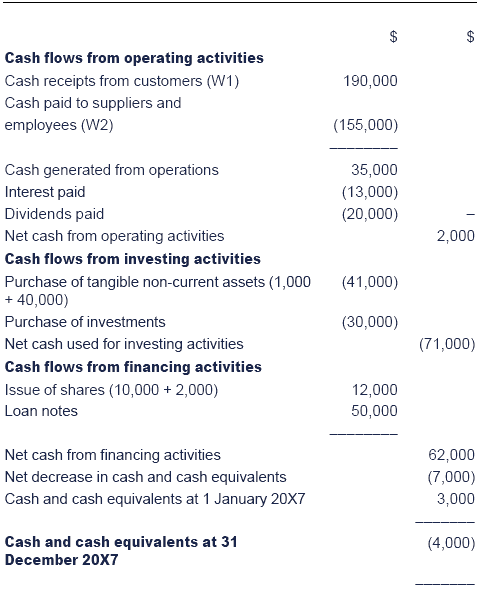

Workings
(W1) Receipts from sales
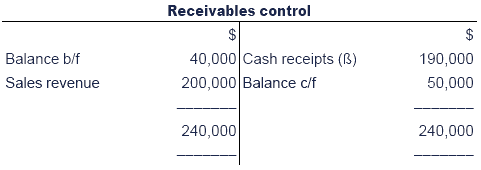
(W2) Payables and wages control
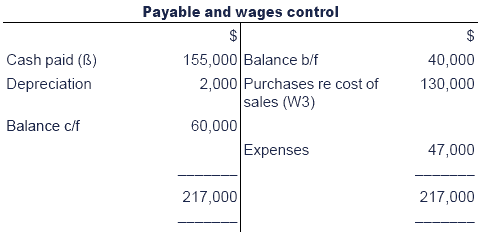
(W3) Cost of sales

Tutorial note Little information has been given as tothe nature of the costs of the company; for example, no information issupplied on wages and salaries. The payments figure thus includes allcash outflows relating to trading activities. Depreciation would havebeen charged in either cost of sales or expenses and this needs to beadjusted for. It does not matter whether the adjustment is shown in thepayables control or the cost of sales accounts.
(b) Algernon has investedsubstantially in buildings, investments, inventory and receivables inthe year. The finance has come from new share capital in part but mainlyfrom loans. The equity to assets ratio of the company has thusdecreased. The working capital has been financed by an equal increase intrade payables.
The profits have been fully distributed as dividends despite thehalving of profits from last year. It might have been wiser to cut backon dividends in the period of expansion until the benefits of theexpansion are seen in the form of higher profits.


 Test your understanding 8
Test your understanding 8
The correct answer is B
A loss on disposal should be added back to profit as it is a non-cash expense.


 Test your understanding 9
Test your understanding 9
The correct answer is C
Dividends received involve a cash receipt. The other transactions do not involve a movement of cash.


 Test your understanding 10
Test your understanding 10
The correct answer is D

Note that the movement in the interest accrual is not part of thereconciliation as this is dealt with within the Interest paid line ofthe statement of cash flows.

|
Created at 5/24/2012 3:39 PM by System Account
(GMT) Greenwich Mean Time : Dublin, Edinburgh, Lisbon, London
|
Last modified at 5/25/2012 12:53 PM by System Account
(GMT) Greenwich Mean Time : Dublin, Edinburgh, Lisbon, London
|
|
|
|
 |
Rating
:
|
 Ratings & Comments
(Click the stars to rate the page) Ratings & Comments
(Click the stars to rate the page)
|
 |
Tags:
|
|
|
|
|